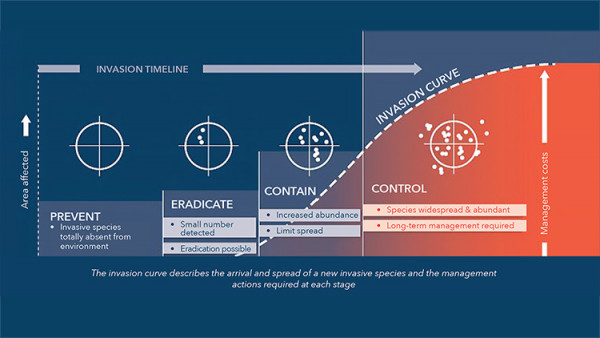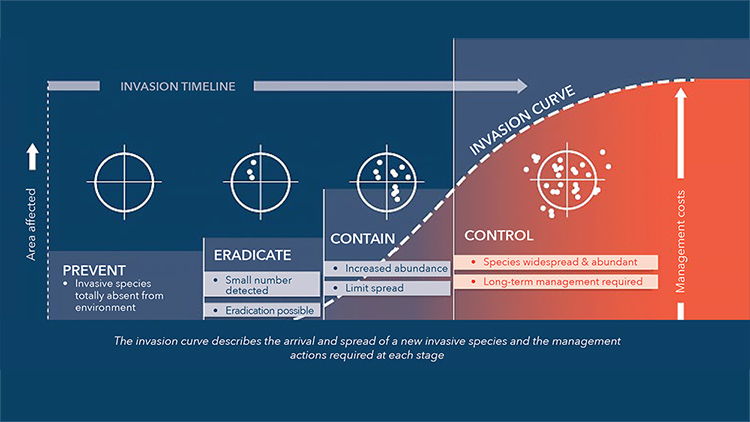Flattening the curve – horticulture style
13 April 2022
Written by Eve Pleydell, HortNZ risk policy advisor
First published in the April 2022 issues of The Orchardist and NZGrower.

Figure 1 (see larger below): An invasion curve showing how control options change as the size of an invading pest population increases over time and across larger areas of a country. In reality, knowing when eradication is no longer feasible or when long-term management is the only real option left is not straight forward. Image sourced from Invasive Species Council, Australia. Invasion-Curve - Invasive Species Council
If a new plant pest enters the country, everyone one wants to get rid of it as fast as possible but sometimes eradication is not possible. What can growers do to help flatten an invasion curve?
Key points
- Eradication of an invasive pest or disease is not always feasible.
- Alternative options include trying to contain or manage the pest.
- At all stages of the invasion curve growers can minimise the risk to and impacts on their business by using good on-farm biosecurity practices.
In New Zealand we are fortunate to be free from many pests and diseases that occur in other countries. To protect this status and support our primary industries we impose some of the strictest biosecurity border controls in the world. However, as the international movements of people, goods, and mail increases, our country is coming under greater invasion pressure from unwanted pests and diseases and it is not possible for border controls alone to provide 100 percent protection.
When an invasive plant pest is detected in New Zealand for the first time, the Ministry for Primary Industries (MPI) works with the affected sector to control the local situation, assess the national situation, and decide on the best control strategy. While eradication of the pest is often the most desirable outcome, the chances of eradication being successful decreases as the length of time the pest has been here and the geographical distance it has spread over increase.
Eradication is also more difficult if the pest is biologically programmed to be a successful invader. For example, pests capable of spreading across long distances fast, or that reproduce rapidly, or that are hard to detect early are likely to be more challenging to eradicate. Think of the difference between the original strain of Covid-19 that as a country we successfully eliminated using lockdowns and the Omicron strain that spreads far too quickly for elimination to be feasible. Sometimes a strategy other than eradication is forced upon us by the characteristics of the situation.
The pest control options available at different stages of an invasion can be illustrated using an invasion curve. If the size of an invading pest population is already too large for national eradication to be successful, it may still be possible to contain the infestation in a particular part of the country using localised control measures. However, if the pest has well and truly established itself then we all have to learn to live with it and develop the best long-term management strategy to minimise its negative impacts.
In recent years, the United Kingdom and Australia both made quite rapid decisions not to pursue eradication of a significant invasive plant pest. (See the case studies below.) Instead, they focussed on industry, science and government working together to flatten the invasion curve by developing long-term management strategies that effectively minimise pest-related damage and impacts.
Growers play key roles at every stage of an invasion curve. While some actions may be mandated on growers by MPI as part of a biosecurity response, enhancing general biosecurity practices on farms is also important for pest and disease control. It can be the actions of growers that stop a pest in its tracks and achieve eradication, as demonstrated recently by the pea growers of Wairarapa. But when a pest or disease does become locally or nationally established it is also the growers who are the main players in preventing huge population explosions that then become very challenging to control. The actions we take here within New Zealand are critical parts of the overall biosecurity system. Border protection alone cannot keep our businesses and communities safe from harm from unwanted pests and diseases, but there is a lot growers can do to mitigate the risks posed by these invaders to their own farm and the country.

References
Agriculture & Horticulture Development Board. (2017). Knowledge Library. Containing the spread of spotted wing drosophila (SWD). Kenilworth, Warwickshire, UK. Retrieved 03 10, 2022, from https://ahdb.org.uk/knowledge-library/containing-the-spread-of-spotted-wing-drosophila-swd
CAB International. (2021). Drosophila suzukii (spotted wing drosophila). Invasive Species Compendium. Wallingford, Oxon, UK. Retrieved 03 10, 2022, from https://www.cabi.org/isc/datasheet/109283
Cesar Australia. (2020). Fall Armyworm Continuity Plan for the Australian Grains Industry, Version 1. Canberra: Plant Health Australia. Retrieved 03 10, 2022, from https://www.planthealthaustralia.com.au/wp-content/uploads/2020/11/Fall-Armworm-Continuity-Plan-2.pdf
Government of Western Australia. (2021, July 05). Fall armyworm in Western Australia. Dept of Primary Industries & Regional Development. Perth. Retrieved 03 10, 2022, from https://www.agric.wa.gov.au/fall-armyworm-western-australia
Plant Health Australia. (2020). Fall armyworm. Canberra, Australia. Retrieved 03 10, 2022, from https://www.planthealthaustralia.com.au/fall-armyworm/
Queensland Government. (2020, March 05). Fall armyworm – should you be concerned? The Beatsheet. Brisbane. Retrieved 03 10, 2022, from https://thebeatsheet.com.au/fall-armyworm-should-you-be-concerned/
